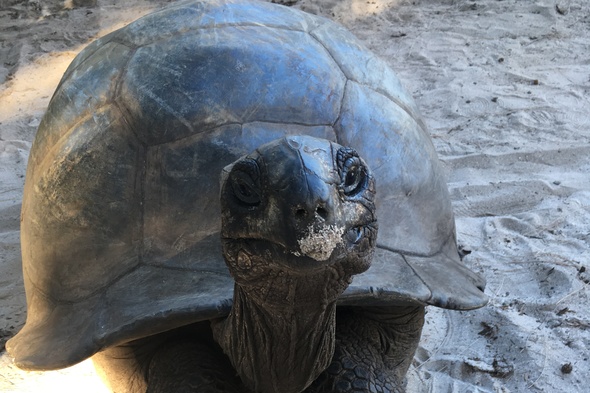Embarking at the port of Victoria on Mahé, the largest island, we set sail heading south west for Aldabra. We stopped at Desroches on the way to get used to clambering aboard our zodiacs, and for some snorkelling practice. The weather was not good to start with, and one night there was a three metre swell!

Aldabra is the world's second largest coral atoll, 700 miles from Mahé, and was declared a UNESCO World Heritage Site in November 1982. There are four main islands and a central shallow lagoon teeming with eagle rays and sea turtles. The area is tidal and huge numbers of fish come and go with the currents through channels out to the open sea.

We landed at Picard Island and were shown around by the rangers working on the island. 100,000 giant tortoises live on Aldabra, and they were strolling around eating leaves or relaxing in the shade. Hundreds of turtles drag themselves onto the beaches to lay their eggs, and we found one having a rest before her final effort back to the sea.
The fossilised coral rocks were covered in mangroves, and they support large colonies of nesting boobies and great frigate birds. We cruised around the lagoon in zodiacs and got up close to the enormous frigates, the males puffing out their red chest feathers.

As the tide began to turn our zodiacs were positioned outside one of the channels and we all snorkelled, drifting along letting the current take us back into the lagoon, while we watched the turtles and fish swimming beneath us. Less than 1,000 people visit Aldabra every year, so it was a great privilege. On the way back to the ship, as the sun was setting, a family of dolphins came leaping out of the water in front of us, a magical moment.

We also visited Cosmoledo, a remote island with huge colonies of nesting red-footed and masked boobies, sooty terns and noddies.
Another interesting stop was the Farquahar Islands, which were hit by a cyclone in 2016. The fierce 350 km/hour winds destroyed all the buildings except for the cyclone shelter and vegetation was uprooted, though it is now starting to grow back. Fishermen fly in to neighbouring islands and sail over to catch giant trevally, which you may have seen recently on the BBC's Blue Planet 2, leaping out of the water to catch low flying birds.

Praslin is the second largest island in the Seychelles, 36 miles northeast of Mahé. We visited the Vallée de Mai, a UNESCO World Heritage Site of natural palm forest famous for the coco de mer tree, which can grow up to 27 metres high with up to 35 nuts on one tree.
The tiny island of La Digue is beautiful, known for its huge granite boulders on the shores. Bicycles are the main mode of transport, so we cycled along the coast road and swam at stunning Grand Anse.

Our expedition team was excellent, with specialists in birdwatching, marine life and geology, and every evening they gave short lectures to prepare us for the activities next day. The atmosphere on board was very friendly, the crew were amazing, ready with a rum punch or champagne on our return each day, and there was such a great choice and excellent service at mealtimes.
Silver Discoverer is an older vessel, but comfortable. Expedition cruising is all about the destination, not the ship, and we spent so much time ashore that our butler was virtually redundant.





